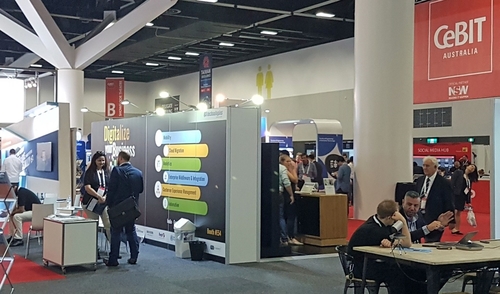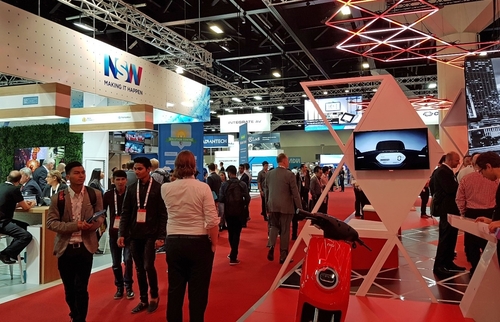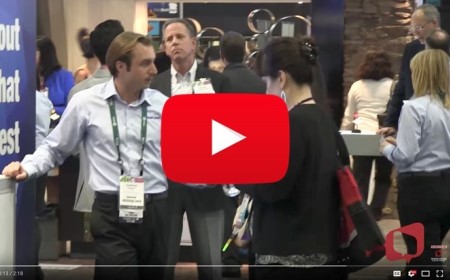It’s an expensive exercise to exhibit your company at a trade show. Yet so many companies exhibit themselves poorly, leaving these events with little more than sore feet. So what should you do to maximise the return on your investment?
At my recent visit to CeBIT I saw lots of examples of this, reminding me of the old John Cleese video “How not to exhibit yourself”. In walking through the exhibition hall at CeBIT, often I could not understand what an exhibitor was offering or what their product was supposed to do. The sales messaging around their company and product was either generically bland, ambiguous, or even contradictory. By not properly preparing they were potentially wasting money and were going to achieve a less than ideal show ROI, and possibly wonder why.

Shows, events and demonstrations
That means getting your company/product positioning and messaging right. As a minimum your message should include the basic 4 as succinctly as possible.
Who are you targeting? What does your product do? Why would the customer want it? How are you different?
If a prospect can’t understand these basics then the nature of a trade show is, there is probably another “bright shiny” booth just down the aisle to attract ones’ attention.
An observation was many of the exhibitors the booth signage was either really cluttered with lots of text or graphics that could not be easily deciphered and just confusing. Or the complete opposite, where the stand design, graphics and layout was devoid of any meaningful information to attract my attention or give a hint of what they were offering.
Everyone pays the about same amount per square metre for their stand, However, event and stand effectiveness per square meter begins with firstly being able to attract the right prospects onto your stand so you can talk to them.
What are you selling?
“At XXXXX we’re obsessed with innovation. We seek out like minded companies that share our hunger for success and empower them with cutting edge technology. Our beautifully designed products solve the most complex problems. Over the last 10 years we have built 800+ products for some of the world’s leading brands, expanded across three continents and launched our own successful start up ventures. Talk to us today and together we will build technology of your tomorrow”
As this was an alphabetical listing, not by technology type, I have no idea what they do or for what type of client. I did not make a beeline for their stand…….
Cutting through the acronyms & buzzwords
I love technology as much as the next person, (perhaps more), but overuse of TLA’s, tech speak and buzzwords as an opening line when you step onto a stand is not the best sales qualifying approach.
The event elevator pitch
I visited CeBIT with my business partner Moheb Moses, and as it turned out we both visited the same stand but not together, and spoke to two different company representatives. Amazingly we got two different pitches, one that was full of acronyms that Moheb found unintelligible and had no idea what their product did. We revisited together and were approached by a second staff member who was marginally better in that we at least figured out what the product did. However, while we now at least understood what it did, and understood it had some very clever technology built in, we could not figure out why we needed it when there were existing alternatives either free or a fraction of the price. They had not created enough need or perceived value in our minds. Therefore, for us it was clever technology but way too expensive compared to known alternatives, so no interest from us.
Creating, testing and rehearsing a show elevator pitch for all staff on the stand is an essential element of having a successful show. If you can’t explain yourself quickly and succinctly to a potential prospect, in order to qualify them in or out for a more in depth conversation within 60 seconds, then you probably need to revisit the elevator pitch.

Leads, leads, leads or time wasters?
We saw a number of stands where they were indiscriminately scanning or collecting business cards of everyone that came past their stand. This was often through give aways ranging from toys, coffees, chocolates etc or just staff accosting people for their business card to go into a draw for something, if you were within a metre of their stand boundary.
CeBIT was a free to enter technology show. The only qualification required to be able to enter the exhibition space was that you had to turn up. The net result will be potentially hundreds of names collected by some exhibitors, but with little or no qualification of the “lead”. Names by themselves are of little to no value. We would argue in fact worse than no value, as assuming they are followed up there is a post event time and cost to do so for a low or no return.
It is much easier to qualify in or out at the event so real prospects can be followed up appropriately. Give me 5 qualified leads any day before the names of a hundred attendees.
Lessons for the channel
Getting your event messaging right (and properly coordinated) is the first and foremost responsibility of any company attending a trade event hoping to get a decent return on their (or their vendor’s MDF) money and time.
CeBIT was a reminder that event success starts well before the doors open. This preparation needs to often start many months prior to the event itself. Then there is the planning for the post event activities including lead management, as well as any event analysis i.e. should you do it again, if so what would you do differently next time?
Channel Dynamics has a range of messaging tools, resources and training programs described on our web site. We have been helping vendors, disti and reseller sales people improve their sales effectiveness for over 12 years now. So, before your next event give us a call to see how we can help you improve your event ROI.
What is the worst behaviour you have seen at a trade show?



